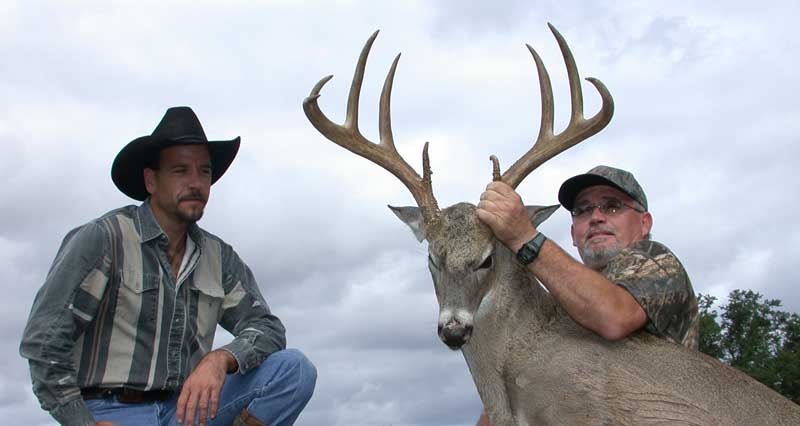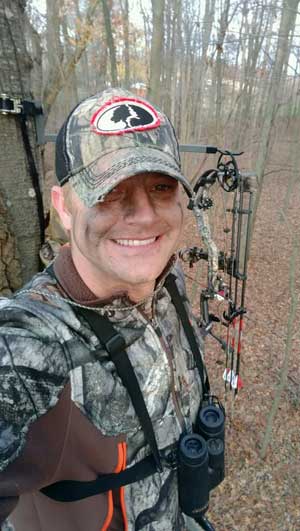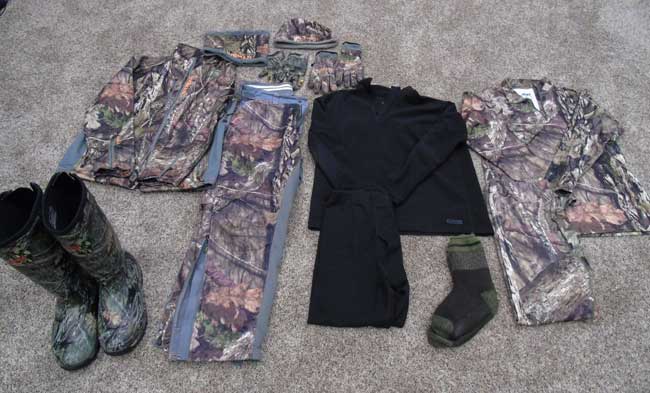Chris Jones | Mossy Oak ProStaff

I've been bowhunting several times, since I took Colton on his first deer hunt. Although I've seen several nice bucks that I could have shot, I'm not going to shoot until I see the buck I really want to take. Statewide, a hunter can take up to three bucks a season, regardless of the weapon. However, each county in Texas has its own regulations as to how many deer of either sex that hunters can take.
Some counties are nonrestrictive on the size of antlers a buck has to have before you can take him, and some counties are restrictive on how many points a buck has to have before you can take him. In those counties, you may only be able to take one buck that has two branched antlers or more, and the buck has to have an inside spread of the main beams 13 inches or wider.
In some of the counties, you can take two bucks without any antler restrictions. The county I live in has an antler restriction. So, I only can take one buck in my county, and that buck has to have two branched antlers and an inside spread of the main beams 13 inches or more. That’s the reason I have three different hunting spots in three different counties. I legally can take three bucks per season - one in my home county and two bucks in counties without antler restrictions.
When you buy your Texas deer license, you get a total of five tags. Of the five tags, you get three tags that will say buck or antlerless deer, and two tags will say doe only. So, you can shoot no bucks and take five does. In some counties, you can shoot one buck and four does. In other counties, you can shoot two bucks and three does. So far this season, I've seen one buck that I really want to take, but he’s not been in bow range. He looks like he’s a 6-1/2-year-old deer, and he’ll score in the high 140s.
In the early season, the bucks are really hard to pattern, especially if you're trying to take one particular buck. Later in the season, the bucks will be easier to pattern. After gun season arrives, the bucks learn routes they can take that don’t put them in front of a hunter with a rifle. So, in late deer season here in Texas, the bucks are much easier to pattern than in early season. During rifle season, I've learned that the bucks will usually come out of thick cover at the same time of day in the same places, because they haven’t had any hunting pressure there. The does are much easier to pattern, since they generally come out of thick cover at the same spot every day.
I live about 1-1/2 hours west of Dallas in Springtown, Texas. I'm often asked, “Why does Texas have so many big deer?”
 I explain that the word “big” refers to antler size and not body size, because in many areas of Texas, the bucks will have small bodies and big antlers. One of the reasons Texas grows big antlered deer is because in some sections of Texas, we have numbers of oak trees dropping acorns every year. Also, most landowners in Texas feed the deer. In south Texas, we find really big-bodied deer as well big-antlered deer. Because Texas is such a big state, if you're planning on coming here to hunt, make sure you know the counties that produce the biggest-bodied and the biggest-racked deer. In other counties, the deer may have small bodies and big racks. In south Texas is where the deer live with big racks and big bodies.
I explain that the word “big” refers to antler size and not body size, because in many areas of Texas, the bucks will have small bodies and big antlers. One of the reasons Texas grows big antlered deer is because in some sections of Texas, we have numbers of oak trees dropping acorns every year. Also, most landowners in Texas feed the deer. In south Texas, we find really big-bodied deer as well big-antlered deer. Because Texas is such a big state, if you're planning on coming here to hunt, make sure you know the counties that produce the biggest-bodied and the biggest-racked deer. In other counties, the deer may have small bodies and big racks. In south Texas is where the deer live with big racks and big bodies.
Even though the county I live in is not noted for having really big deer every year, there will be bucks harvested in my county that will score from 150 inches to 180 inches plus. The best buck I've ever seen in the wild will have scored about 190 inches. The best buck I've ever taken with my bow scored 149-7/8 inches, and the best buck I've taken with a rifle scored 163 inches.
Public-Land Hunting in Texas:
The best public hunting in Texas will be on the draw hunts, and I believe these hunts are only available to Texas residents. The biggest deer usually harvested on public lands are often taken during bow season. Texas is a really big state, and we have large population centers. Many of these hunters usually hunt state Wildlife Management Area (WMA) lands.
To avoid the crowds on public lands, go during the week. You may not see another hunter then. But instead of hunting WMAs, I suggest that a newcomer to Texas consider hunting U.S. Army Corps of Engineers’ land where you can search for the closest land near you or U.S. Forest Service land where you also can search for the nearest land to where you live and download maps, especially during bow season.
If you're coming to Texas to hunt public lands, I suggest that you arrive one or two days before you plan to hunt and spend those days scouting. Don’t be afraid to get deep into that public hunting land. Most hunters who hunt public lands will be hunting close to the parking areas, since they can park their vehicles, walk 100 or 200 yards, sit down and hope a deer shows up. Instead, look for a deep corner of the property that’s hard to reach and maybe more than a mile away from a parking area.
Chris Jones is Mossy Oak’s Regional ProStaff Manager for whitetails, turkeys and big game for Mossy Oak in the State of Texas. But Jones also hunts Oklahoma, Arkansas, Ohio and Tennessee.



























